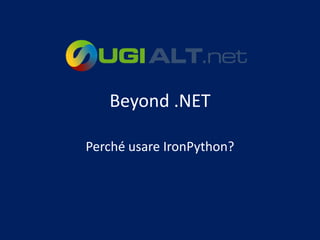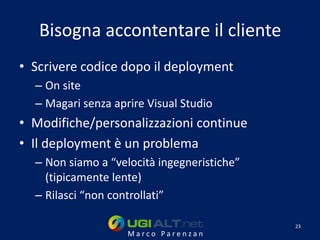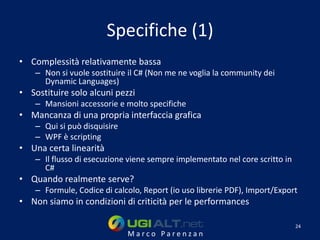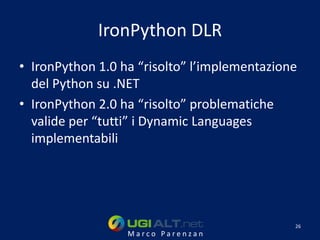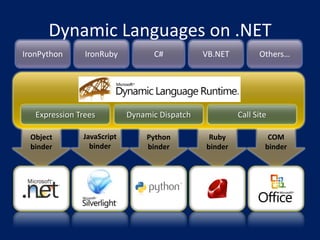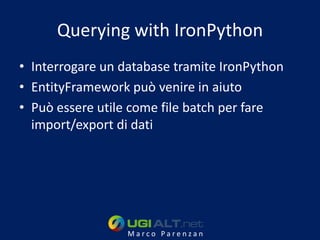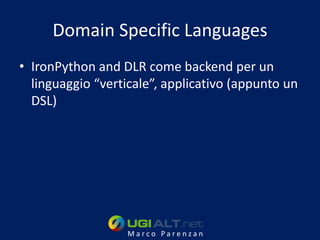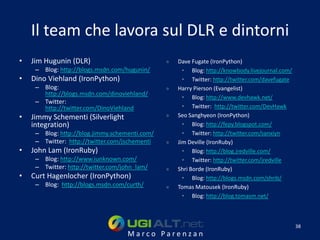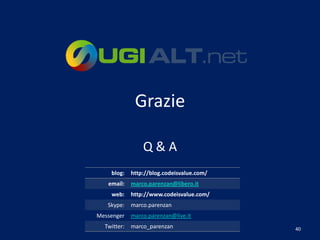Dynamic Language Programming For The Statically Typed Programmer
- 1. Beyond .NET Dynamic Language Programming for the Statically Typed Programmer
- 2. Beyond .NET? • Bisogna essere più precisi – Beyond statically typed (“traditional”, “original”) .NET – Ma .NET è sempre lì – “Dynamic” è qualcosa in più 2 Marco Parenzan
- 3. Confronto Static Dynamic Languages Languages Robusto Semplice e stringato Interpretato Performante (no compilazione) Strumenti “implicitamente “intelligenti” tipizzato” Migliore scalabilità Meta-programming 3 Marco Parenzan
- 4. Le peculiarità di un Dynamic Language • Semplice e stringato – È una scelta tipica di chi ha sviluppato questi linguaggi – Sintassi leggera – Molte funzioni lasciate in API in linguaggi statici sono implementate nel linguaggio • Interpretato – È la diretta conseguenza della semplicità, evitando la “complicazione” di un processo di compilazione • Implicitamente tipizzato – Il tipo è associato ai valori, non alle variabili – Non permettono di verificare e notificare gli errori di tipo se non quando vanno in esecuzione 4 Marco Parenzan
- 5. Metaprogramming • Il metaprogramming è la scrittura di un programma in grado di scrivere o manipolare altri programmi o se stesso • Un metaprogramma effettua a tempo di esecuzioni operazioni che sarebbero, in condizioni normali, effettuate a tempo di compilazione • L'obiettivo del metaprogramming è quello di produrre programmi in grado di adattarsi dinamicamente ad una configurazione che cambia nel tempo, senza intervento umano 5 www.xedotnet.org Marco Parenzan
- 6. Alune definizioni • Metaprogramma: il prodotto dell'atto di metaprogramming • Metalinguaggio: linguaggio utilizzato per scrivere il metaprogramma • Se il metalinguaggio ed il linguaggio di programmazione coincidono, l'attività di metaprogramming prende il nome di reflection 6 www.xedotnet.org Marco Parenzan
- 7. Quale scegliere? • Due “generazioni” di linguaggi – Nativi (con virtual machine proprietaria) – Su Runtime (.NET o JVM) • Alcuni – Python (IronPython, Jython) – Ruby (IronRuby, JRuby) • Perché portare Python o Ruby su .NET o JVM? – Py o Rb usano il runtime – Py o Rb sono accessibli dal runtime (e questo è il nostro caso) 7 Marco Parenzan
- 8. Beyond .NET Python e IronPython
- 9. Cos’è Python? • Un linguaggio di programmazione general purpose • Sviluppato da Guido van Rossum nel 1991 • Un linguaggio dinamico usato spesso come linguaggio di scripting • Supporta diversi paradigmi di programmazione: – Object Oriented – Imperative – Functional • È stato creato con questi obiettivi in mente: – Leggibilità del codice – Sintassi minimalista – Un esteso set di librerie – Duck Typing 9 Marco Parenzan
- 10. Cos’è IronPython? • È una implementazione del linguaggio Python su piattaforma .NET – IronPython è scritto interamente in C# • Creato da Jim Hugunin – sviluppatore anche di Jython (Python su JVM) • Voleva scrivere un paper dal titolo “Why .NET is a Terrible Platform for Dynamic Languages” – “It was a little less than a year ago that I first started investigating the Common Language Runtime (CLR). My plan was to do a little work and then write a short pithy article called, "Why .NET is a terrible platform for dynamic languages”" http://www.ironpython.com/old.html • Nel settembre del 2004 iniziava a lavorare in Microsoft – “My plans changed when I found the CLR to be an excellent target for the highly dynamic Python language. Since then I've spent much of my spare time working on the development of IronPython” http://www.ironpython.com/old.html – http://www.python.org/community/pycon/dc2004/papers/9/ – http://conferences.oreillynet.com/presentations/os2004/hugunin_jim_up.ppt 10 Marco Parenzan
- 11. IronPython Performances (2004) Test Descrizione Prestazione parser (b0) heavy OO plus meta programming x1.1 faster stacks (b1) handling of stack overflow x2.1 faster PI (b2) using generators to compute π same sorting (b3) many different comparsions and sorting x1.5 faster parser2 (b4) reprise of parser with different input x1.2 slower builtins (b5) testing unicode, complex numbers, … x2.3 slower iterators (b6) – looping and overflow from int to long x1.2 faster Python-2.3 OSCon 2004 – IronPython 0.6 1.7x faster than Python-2.3 on IronPython pystone IronPython (Mono) 0 1 2 3 4 5 6 7 8 9 10 11 12 time (seconds) b0 b1 b2 b3 b4 b5 b6 11 Marco Parenzan
- 12. Performances (2009) • Performance Comparisons Test CPy2.6.1 IPy2.6 – http://ironpython.codeplex.com/wikipage Hello World 0.0655611s 2.1076478s ?title=IronPython%20Performance • IronPython 2.6 Final PyStone 1.1 39239.6pys/s 55765.7 pys/s – http://ironpython.codeplex.com/wikipage Richards 611.8 1400.05 ?title=IP26FinalVsCPy26Perf&referringTitle =IronPython%20Performance 12 Marco Parenzan
- 13. Performances (2009) PyBench 2.0 Test IPy2.6 CPy2.6.1 Δ Test IPy2.6 CPy2.6.1 Δ BuiltinFunctionCalls: 403ms 1737ms -76.8% Recursion: 559ms 2214ms -74.8% BuiltinMethodLookup: 606ms 1835ms -67.0% SecondImport: 966ms 1248ms -22.6% CompareFloats: 28ms 1075ms -97.4% SecondPackageImport: 1059ms 1313ms -19.3% CompareFloatsIntegers: 403ms 1354ms -70.2% SecondSubmoduleImport: 1496ms 1724ms -13.2% CompareIntegers: 27ms 853ms -96.9% SimpleComplexArithmetic: 605ms 1324ms -54.3% CompareInternedStrings: 395ms 1237ms -68.1% SimpleDictManipulation: 2072ms 1094ms 89.4% CompareLongs: 29ms 1071ms -97.3% SimpleFloatArithmetic: 495ms 1475ms -66.4% CompareStrings: 477ms 1428ms -66.6% SimpleIntFloatArithmetic: 558ms 760ms -26.6% CompareUnicode: 400ms 1188ms -66.3% SimpleIntegerArithmetic: 542ms 757ms -28.4% ComplexPythonFunctionCalls: 2149ms 2574ms -16.5% SimpleListManipulation: 1384ms 911ms 51.9% ConcatStrings: 5129ms 3004ms 70.7% SimpleLongArithmetic: 1075ms 1197ms -10.2% ConcatUnicode: 3040ms 2602ms 16.8% SmallLists: 1464ms 1623ms -9.8% CreateInstances: 839ms 2035ms -58.8% SmallTuples: 871ms 1429ms -39.1% CreateNewInstances: 1121ms 1552ms -27.8% SpecialClassAttribute: 3210ms 1103ms 190.9% CreateStringsWithConcat: 2880ms 1113ms 158.8% SpecialInstanceAttribute: 3865ms 1198ms 222.7% CreateUnicodeWithConcat: 809ms 1250ms -35.3% StringMappings: 3055ms 2353ms 29.8% DictCreation: 2276ms 1052ms 116.3% StringPredicates: 1346ms 1798ms -25.1% DictWithFloatKeys: 2070ms 2956ms -30.0% StringSlicing: 1414ms 1522ms -7.1% DictWithIntegerKeys: 1818ms 851ms 113.8% TryExcept: 260ms 573ms -54.6% DictWithStringKeys: 1990ms 1043ms 90.7% TryFinally: 949ms 1808ms -47.5% ForLoops: 562ms 658ms -14.6% TryRaiseExcept: 63930ms 1083ms 5805.3% IfThenElse: 291ms 838ms -65.3% TupleSlicing: 2090ms 1517ms 37.8% ListSlicing: 3713ms 1493ms 148.7% UnicodeMappings: 2059ms 949ms 117.0% NestedForLoops: 640ms 1054ms -39.3% UnicodePredicates: 1391ms 1297ms 7.2% NormalClassAttribute: 2961ms 1124ms 163.4% UnicodeSlicing: 1399ms 1737ms -19.5% NormalInstanceAttribute: 3710ms 1030ms 260.3% WithFinally: 652ms 2199ms -70.4% PythonFunctionCalls: 325ms 1647ms -80.3% WithRaiseExcept: 71699ms 1681ms 4164.4% PythonMethodCalls: 3556ms 1866ms 90.6% 13 Marco Parenzan
- 14. Aggiornamento IronPython al 23 gennaio 2010 • http://ironpython.codeplex.com/ • .NET 3.5sp1 – IronPython 2.6 • 11 dicembre 2009 • http://ironpython.codeplex.com/Release/ProjectReleases.as px?ReleaseId=12482 • .NET 4.0 Beta 2 – IronPython 2.6 CTP for .NET 4.0 Beta 2 • 21 ottobre 2009 • http://ironpython.codeplex.com/Release/ProjectReleases.as px?ReleaseId=28125 14 Marco Parenzan
- 15. Michael Foord autore di IronPython in Action • “Why IronPython?” http://ironpython-urls.blogspot.com/2009/12/why-ironpython.html – No type declarations – First class and higher order functions – No need for generics, flexible container types instead – Protocols and duck-typing instead of compiler enforced interfaces – First class types and namespaces that can be modified at runtime – Easy introspection (reflection without the pain) 15 Marco Parenzan
- 16. No type declarations • a = 10 • b = "10" • a+b #fail • a+int(b) #ok 20 • str(a)+b #ok '1010' • a = "10" #ok • a+b #ok '1010' Marco Parenzan
- 17. First class and higher order functions • def Somma(a, b): • return a+b • Somma(4,5) # = 9 • s = Somma • s(4,5) # = 9 Marco Parenzan
- 18. No need for generics, flexible container types instead • class BinaryOp: • def __init__(self, a, b): • self.a = a • self.b = b • def Somma(self): • return a+b • ops = [] • ops.append(BinaryOp(2,4)) • ops.append(BinaryOp(5,5)) • ops.append(BinaryOp(8,2)) • for op in ops: • print op.Somma() Marco Parenzan
- 19. Protocols and duck-typing instead of compiler enforced interfaces • class CustomOps: • def __iter__(): • yield new BinaryOp(3,5) • yield new BinaryOp(4,3) • yield new BinaryOp(2,5) • for op in ops: • print op.Somma() Marco Parenzan
- 20. First class types and namespaces that can be modified at runtime • ## aggiungere un metodo alla classe • def Differenza(self): • return a-b • BinaryOp.Differenza = Differenza • ## aggiungere un metodo ad una specifica istanza • import new • def Moltiplica(self): • return a*b • ops[0].Moltiplica = new.instancemethod(Moltiplica, ops[0], BinaryOp) Marco Parenzan
- 21. Easy introspection (reflection without the pain) • dir(BinaryOp) • dir(ops[0]) • dir(ops[1]) Marco Parenzan
- 22. Beyond .NET Perché usare IronPython?
- 23. Bisogna accontentare il cliente • Scrivere codice dopo il deployment – On site – Magari senza aprire Visual Studio • Modifiche/personalizzazioni continue • Il deployment è un problema – Non siamo a “velocità ingegneristiche” (tipicamente lente) – Rilasci “non controllati” 23 Marco Parenzan
- 24. Specifiche (1) • Complessità relativamente bassa – Non si vuole sostituire il C# (Non me ne voglia la community dei Dynamic Languages) • Sostituire solo alcuni pezzi – Mansioni accessorie e molto specifiche • Mancanza di una propria interfaccia grafica – Qui si può disquisire – WPF è scripting • Una certa linearità – Il flusso di esecuzione viene sempre implementato nel core scritto in C# • Quando realmente serve? – Formule, Codice di calcolo, Report (io uso librerie PDF), Import/Export • Non siamo in condizioni di criticità per le performances 24 Marco Parenzan
- 25. Beyond .NET IronPython come uno scripting Language
- 26. IronPython DLR • IronPython 1.0 ha “risolto” l’implementazione del Python su .NET • IronPython 2.0 ha “risolto” problematiche valide per “tutti” i Dynamic Languages implementabili 26 Marco Parenzan
- 27. Dynamic Languages on .NET IronPython IronRuby C# VB.NET Others… Dynamic Language Runtime Expression Trees Dynamic Dispatch Call Site Object JavaScript Python Ruby COM binder binder binder binder binder
- 28. Aggiornamento IronRuby al 23 gennaio 2010 • http://ironruby.codeplex.com/ • .NET 3.5sp1 – IronRuby 1.0 RC1 (0.9.3.0) • 20 novembre 2009 • http://ironruby.codeplex.com/Release/ProjectReleases.aspx?ReleaseId=35312 – IronPython binaries for ironruby-1.0 RC1 interop (0.9.3.0) • 20 dicembre 2009 • http://ironruby.codeplex.com/Release/ProjectReleases.aspx?ReleaseId=35312 #DownloadId=97919 • .NET 4.0 Beta 2 – IronRuby CTP for .NET 4.0 Beta 2 • 21 ottobre 2009 • http://ironruby.codeplex.com/Release/ProjectReleases.aspx?ReleaseId=35312 #DownloadId=97919 28 Marco Parenzan
- 29. Aggiornamento DLR al 23 gennaio 2009 • http://dlr.codeplex.com/ • .NET 3.5sp1 e .NET 4.0 Beta 2, solo src – 22 ottobre 2009 – http://dlr.codeplex.com/Release/ProjectReleases. aspx?ReleaseId=34834 29 Marco Parenzan
- 30. Beyond .NET Alcuni esempi pratici
- 31. Hosting IronPython in .NET • Esempi – Valutazione di espressioni – Esecuzione di procedure – Invocazione di oggetti (dynamic in C# 4.0!) Marco Parenzan
- 32. Querying with IronPython • Interrogare un database tramite IronPython • EntityFramework può venire in aiuto • Può essere utile come file batch per fare import/export di dati Marco Parenzan
- 33. Reports with IronPython • Preferisco usare librerie PDF invece di reporting services • Aggiungere un campo in un report è una cosa comune • Farlo “on-site” senza aprire Visual Studio è meglio Marco Parenzan
- 34. Scripting in WPF • Personalizzare elementi di una tipica applicazione LOB • Oltre a personalizzare i report… • …gestire gli eventi CRUD Marco Parenzan
- 35. Domain Specific Languages • IronPython and DLR come backend per un linguaggio “verticale”, applicativo (appunto un DSL) Marco Parenzan
- 37. Conclusioni • Necessità dello scripting – Risolvere il problema delle personalizzazioni c/o il cliente • Risolto? – È un gran bel passo avanti – Ma è probabilmente meglio un DSL (con backend il DLR) • Credenza di fondo – Scelgo di usare ANCHE un altro linguaggio • “Polyglot programmer” – Accetto il “compromesso” del “dinamico” • Attingere ad un parco di implementazioni (tutte open source) eccezionale in maniera nativa (non interop) – Ruby on Rails 37 Marco Parenzan
- 38. Il team che lavora sul DLR e dintorni • Jim Hugunin (DLR) » Dave Fugate (IronPython) – Blog: http://blogs.msdn.com/hugunin/ • Blog: http://knowbody.livejournal.com/ • Dino Viehland (IronPython) • Twitter: http://twitter.com/davefugate – Blog: » Harry Pierson (Evangelist) http://blogs.msdn.com/dinoviehland/ • Blog: http://www.devhawk.net/ – Twitter: http://twitter.com/DinoViehland • Twitter: http://twitter.com/DevHawk • Jimmy Schementi (Silverlight » Seo Sanghyeon (IronPython) integration) • Blog: http://fepy.blogspot.com/ – Blog: http://blog.jimmy.schementi.com/ • Twitter: http://twitter.com/sanxiyn – Twitter: http://twitter.com/jschementi » Jim Deville (IronRuby) • John Lam (IronRuby) • Blog: http://blog.jredville.com/ – Blog: http://www.iunknown.com/ • Twitter: http://twitter.com/jredville – Twitter: http://twitter.com/john_lam/ » Shri Borde (IronRuby) • Curt Hagenlocher (IronPython) • Blog: http://blogs.msdn.com/shrib/ – Blog: http://blogs.msdn.com/curth/ » Tomas Matousek (IronRuby) • Blog: http://blog.tomasm.net/ 38 Marco Parenzan
- 39. Autori • Michael Foord – Libro: http://www.manning.com/foord/ – Blog: http://www.voidspace.org.uk/python/weblog/index.shtml – Twitter: http://twitter.com/Voidspace • Ivar Porto Carrero – Libro: http://www.manning.com/carrero/ – Blog: http://flanders.co.nz/ – Twitter: http://twitter.com/casualjim 39 Marco Parenzan
- 40. Grazie Q&A blog: http://blog.codeisvalue.com/ email: marco.parenzan@libero.it web: http://www.codeisvalue.com/ Skype: marco.parenzan Messenger marco.parenzan@live.it Twitter: marco_parenzan 40





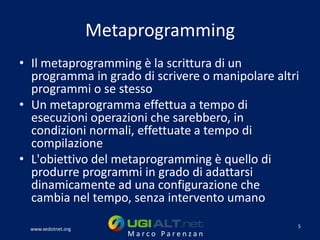
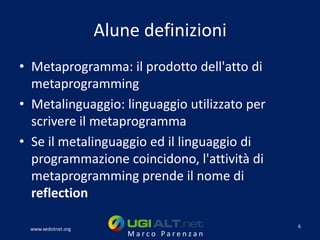
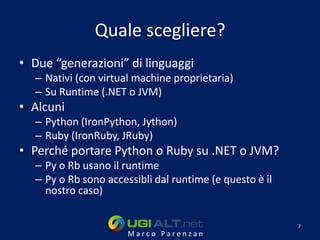
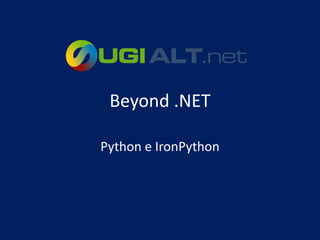
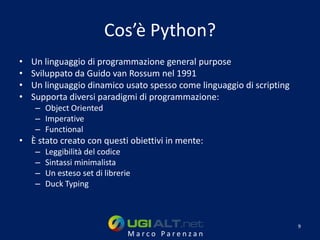
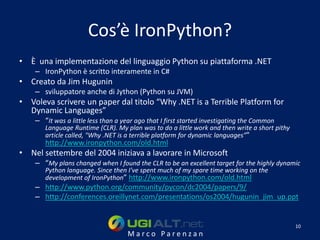
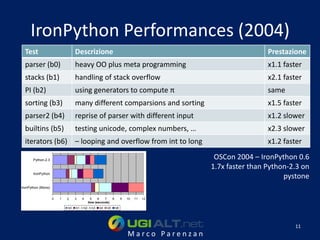
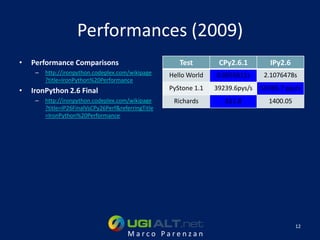
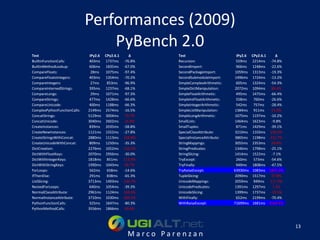
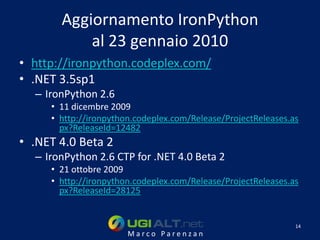
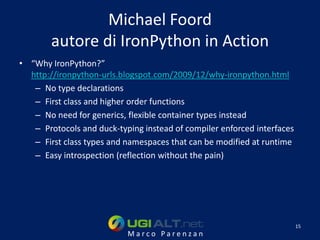
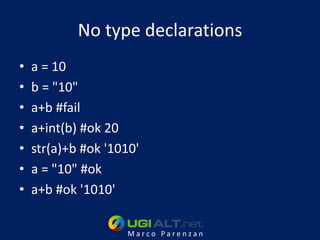
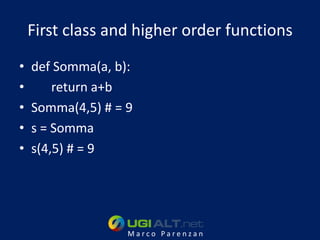
![No need for generics, flexible
container types instead
• class BinaryOp:
• def __init__(self, a, b):
• self.a = a
• self.b = b
• def Somma(self):
• return a+b
• ops = []
• ops.append(BinaryOp(2,4))
• ops.append(BinaryOp(5,5))
• ops.append(BinaryOp(8,2))
• for op in ops:
• print op.Somma()
Marco Parenzan](https://image.slidesharecdn.com/2010-01-23-dynamiclanguageprogrammingforthestaticallytypedprogrammer-100123125022-phpapp01/85/Dynamic-Language-Programming-For-The-Statically-Typed-Programmer-18-320.jpg)

![First class types and namespaces that
can be modified at runtime
• ## aggiungere un metodo alla classe
• def Differenza(self):
• return a-b
• BinaryOp.Differenza = Differenza
• ## aggiungere un metodo ad una specifica istanza
• import new
• def Moltiplica(self):
• return a*b
• ops[0].Moltiplica = new.instancemethod(Moltiplica, ops[0],
BinaryOp)
Marco Parenzan](https://image.slidesharecdn.com/2010-01-23-dynamiclanguageprogrammingforthestaticallytypedprogrammer-100123125022-phpapp01/85/Dynamic-Language-Programming-For-The-Statically-Typed-Programmer-20-320.jpg)
![Easy introspection
(reflection without the pain)
• dir(BinaryOp)
• dir(ops[0])
• dir(ops[1])
Marco Parenzan](https://image.slidesharecdn.com/2010-01-23-dynamiclanguageprogrammingforthestaticallytypedprogrammer-100123125022-phpapp01/85/Dynamic-Language-Programming-For-The-Statically-Typed-Programmer-21-320.jpg)
